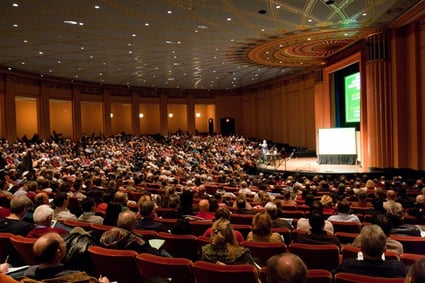Audience response technology can be used in countless settings. Conference organizers, corporate trainers, virtual work teams--the list goes on and on. Here are some of the most common uses for audience response systems:
Meeting, Trade Show, and Convention Presentations
This is probably what many people tend to think of first when they hear about audience response systems, and the connotation makes sense. Anyone who has attended a convention or trade show--especially a national one with thousands of attendees--has probably sat in a large auditorium and listed to a presenter share information and reports with the crowd. Perhaps there has been a chance for attendees to provide feedback to the speakers, via texting, tablets, or even just pen and paper.
A presenter who uses a good audience response technology can get real-time feedback from the crowd with seamless integration into the presentation. Rather than simply guessing what the audience is thinking or collecting information using a clunky method like pen and paper, speakers can use audience response keypads to quickly gather information and data from their listeners.
Instant Electronic Evaluations for Speakers or Sessions

Why wait until after an event ends to send out a survey that asks attendees to try to remember the things they liked and disliked about each part of the event? Sometimes, conference-goers might attend seven or eight workshops in a weekend, perhaps led by dozens of different session coordinators.
Instead of trusting potentially inaccurate memories or losing information to the passing of time, you can get immediate results by providing a feedback opportunity during each session. These electronic evaluations can gather information when the respondent is right there, not trying to remember who they heard from in Workshop #5 and whether or not what that person said was useful.
Anonymous or Tracked Voting and Issue Prioritization
While some events are planned months in advance, that is certainly not the only way to structure a workshop or convention presentation. Imagine an annual convention meeting in which representatives of the board have made themselves available to discuss important issues that the shareholders care about. There are any number of things that could be discussed, but what does the audience actually want to hear?
A quick poll of the audience could help rule out topics that aren’t as important and determine which issues have become the big ones during the weekend. The board can be confident that they are speaking to the issues their attendees are interested in, and the attendees will have higher satisfaction because they feel like their priorities were recognized. This is just one example of how issue prioritization could work in an audience response situation. The same function can be used to take anonymous or tracked votes during the session.
Data Collection of Attendance, Opinions, and Demographics

Data that is collected during an event can be used in the following days and weeks to analyze the event and plan for the next one. Real-time collection allows more accurate recording and a higher response rate than a post-event survey, and the data can be analyzed once the event has ended.
What sessions went well? How did the location of the event affect the attendees? How have the demographics of the event changed from year to the next? Which events had the best and worst attendance? All of this data can be used to measure the successes and growth points for an event.
Distance-Learning and Remote/Multi-Site Meetings
So far, all of the examples on this list have focused on meetings that take place in one physical location, with attendees who are physically present. That is only one aspect of audience response technology use.
Virtual work teams and online classrooms can use this same technology to increase the number of communication avenues available! Adding audience response software to a virtual team’s toolbox can move the discussion away from passive engagement and towards active participation from everyone involved.
Exciting Team Building and Gaming Activities

Gamification has infiltrated corporate America as they attempt to engage consumers, but why not incorporate the same principles during your next team meeting or event?
Data collection and decision making are the industry-leading uses of audience response technology, but who doesn’t like to have some fun? Real-time response software can be a great addition to existing team building exercises for any company or group. Icebreakers, get-to-know-you games, trivia--there are so many options for team-building activities and games during your events.
Employee Orientation and Stakeholder Meetings
When training new employees or giving new information to stakeholders, you want to ensure that what they are hearing is what you are saying. The opportunity to collect questions or feedback from the audience right in the moment can be priceless.
You can clarify something that you didn’t even realize needed to be clarified as long as you find out--right then!--that the people listening still need more information. Why wait until reading through the post-training comments to know what needs to be further explained and discussed?
Compliance, Safety, Sales, Technical, and Military Training Sessions
There are limitless applications to audience response software, including all kinds of training sessions.
Want to prove that your compliance and safety trainees understand the material you have introduced? Quiz them at the end of the session and provide the high percentage of passing scores to your advisory board.
Want to test the effectiveness of your new sales techniques? Demonstrate one of your new strategies for your audience and then poll them for their reactions.
Continuing Education and Professional Development Classes
An audience response system can be incredibly useful for continuing education opportunities, whether those are online or face-to-face. Professional development classes can also benefit from real-time feedback, especially when gathering information about the experience level of each group of participants. Nobody wants to spend an hour going over information only to learn that the participants already knows these details inside and out, so a quick survey of attendees can establish existing knowledge and identify what needs to be addressed.
These are some of the most common uses that OptionPower audience response software supports, and yet this isn’t an exhaustive list by any means. Many of these examples only provide one or two uses for each setting, when the options are quite limitless! Anyone who is responsible for collecting or disseminating information should be aware of the ways that they can utilize audience response software to improve communication, collect accurate and usable data, and make more informed decisions.


